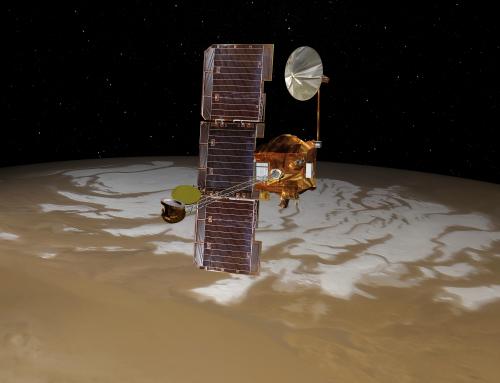
(Artist’s concept of the Mars Odyssey spacecraft – Photo Credit: NASA/JPL-Caltech)
NASA’s Mars Odyssey spacecraft has successfully adjusted the timing of its orbit around Mars as a defensive precaution for comet C/2013 A1 (otherwise known as Siding Spring) which will pass by the Red Planet on October 19.
The comet’s icy nucleus will miss Mars by just 82,000 miles, that’s 17 times closer than the closest recorded Earth-approaching comet, Lexell’s Comet, which flew past our planet in 1770. The nucleus of the comet will miss Mars by about one-third of the distance between Earth and Earth’s moon.
The comet will shed material, sending it hurtling through space at about 35 miles (56 kilometers) per second relative to Mars and Mars-orbiting spacecraft. At that velocity, even the smallest particle could cause significant damage to a spacecraft.
 (Comet Siding Spring observed by the Spitzer Space Telescope in March 2014 – Photo Credit: NASA)
(Comet Siding Spring observed by the Spitzer Space Telescope in March 2014 – Photo Credit: NASA)
Rich Zurek, chief scientist for the Mars Exploration Program at NASA’s Jet Propulsion Laboratory, explained: “The hazard is not an impact of the comet nucleus, but the trail of debris coming from it…Mars will be right at the edge of the debris cloud, so it might encounter some of the particles”.
Therefore, to avoid the comet’s debris, the orbiter fired its thrusters for five and a half seconds. This didn’t change the shape of Odyssey’s orbit, but simply tweaked its timing. The adjustment will place the spacecraft behind Mars during the flyby date when dust particles released from the comet are most likely to reach Mars.
“The modelling predictions for comet Siding Spring suggest a dust-particle impact would not be likely in any case, but this manoeuvre has given us an added protection,” said Mars Odyssey Project Manager David Lehman. “Those dust particles will be travelling so fast that even one hit could end our mission.”
Mars Odyssey has worked at the Red Planet longer than any other Mars mission in history. The spacecraft was launched on April 7, 2001 and arrived at Mars on October 24, 2001. As well as conducting its own scientific observations, the orbiter also provides a communication relay for exploration rovers on the Martian surface.